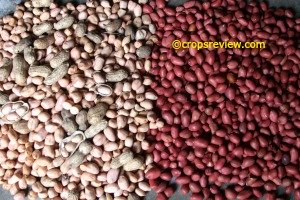The peanut (Arachis hypogaea L.), also called groundnut, is a popular annual crop. It is listed as one among the many leguminous seed crops and also oilseed crops.
Statistics provided by FAOSTAT (2019) of the Food and Agriculture Organization of the United Nations revealed that in 2017 the top 3 producers of groundnuts with shell in the world were China (17092000 tons), India (9179000 tons), and the United States of America (3281110 tons).
Botanically the plant is a legume under the family Fabaceae or Leguminosae rather than a nut.
Just like other members of the family, it produces fruits. Its fruit, often called “nut”, is technically a pod (also “legume”).
It is connected to the stem with an elongated thread-like pedicel called a peg.
This leguminous plant is unique for having fruits that develop underground.
The main economic part of the plant because of its multiple uses is the seed (usually from 1 to 4) which is encased in a pair of hard shells.
The pod or nut is also cooked either fresh or dry and cracked to extract the seeds for a snack.
In addition, the plant has been used as a source of forage.
Moreover, the plant finds more use as an intercrop or as a restorer of soil fertility mainly because as a legume it fixes atmospheric nitrogen through a symbiotic relationship with Rhizobium bacteria.
The fixed nitrogen is subsequently converted into ionic forms which the peanut itself and other plants can absorb.

The seed of the plant is rich in protein and oil.
Highlighting its nutritive value, Hill (1972) wrote that 1 pound of seeds yields 2700 calories but 1 pound of beef contains 900 cal. only.
Why I Grew Peanut
I decided to grow the crop –and the two varieties- for many reasons. The following advantages were considered:
1. I thought that it was a good substitute for corn as a cash crop.
It is easy to grow and the corn farmers in the community where it was to be grown are familiar with its culture.
It has a shorter maturity period of about 90-95 days compared to corn’s 110-115 days.
While drying is a must in corn, peanuts can be harvested even during rainy days and the sacked fresh pods can be delivered wet to the buyer.
Although the established crop will prevent the spraying of herbicides, weeding can be done anyway by hand-pulling or with the use of handheld tools.
2. This legume is short-statured.
Being so, the crop will not hamper the farm plan of planting coconut and fruit trees continuously.
The same will allow an extended view to farther distances at the farm and the perennial crops already planted will remain visible.
3. It being a eudicot with a primary root will hold the soil in place and minimize erosion.
4. The capability of legumes to restore or supplement nitrogen will be beneficial in terms of lower fertilizer input.
5. The peanut crop should be a good choice in making use of the portion of the land that had been cleared instead of allowing the regrowth of weeds and slashing again.
The plants can help suppress weed growth.
6. The need for farm workers until the crop matures is minimal.
This is because it has a relatively short maturity and as traditionally practiced, no pesticides and fertilizers are applied.
7. The growing of the crop can be started with a minimal amount of seeds.
Although the cost of seeds needed per unit area of land is higher compared to corn, this was remedied by procuring only starter amounts (30 kg “Native White” and 10 kg “Red”).
The plan included the sourcing of seeds for the next cropping from the harvested seeds.
8. The Native White and the Red varieties were the only ones available at the time of the search for planting materials.
Both were procured for on-farm comparison.
Lessons Learned in Relation to Varietal Selection
In a nutshell, peanuts should remain a potential choice in crop selection.
However, some issues need to be resolved.
For one, crop selection should also include varietal, or cultivar, selection. This rule applies as well to other crops.
I found out that knowing the intended end use of the product – and buyers’ preferred product- is essential in choosing the variety to be grown.
Indeed, if the end-use is cooked (boiled) fresh pods, the better choice is the Imelda variety. It has bigger pods than the Native White and the Red varieties.
But it’s not just the size.
Peddlers I interviewed prefer this variety because compared to the latter two, the boiled pods do not easily spoil.
Accordingly, leftovers still remain marketable 2 or 3 days after boiling.
The Red variety can also be sold as freshly harvested pods but buying capacity (in General Santos City) is limited to a few sacks.
It’s rather different with the Native White.
There’s no market for freshly harvested pods except only when the supply of Imelda is scant.
There’s an unlimited market for dry seeds of the three peanut varieties.
However, the price of Imelda is lower per unit weight. This is not to say though that for dry seeds Imelda is of inferior quality.
Seed yield and net income should also consider such parameters as pod yield per unit area of land and shelling recovery using a mechanical sheller.
LITERATURE CITED
FAOSTAT. 2019. Production: Countries by Commodity. Retrieved Feb. 26, 2019, from http://www.fao.org/faostat/en/#rankings/countries_by_commodity.
HILL AF. 1972. Economic Botany: A Textbook of Useful Plants and Plant Products. 2nd ed. New Delhi: Tata McGraw-Hill Pub. Co. Ltd. 560 p.
